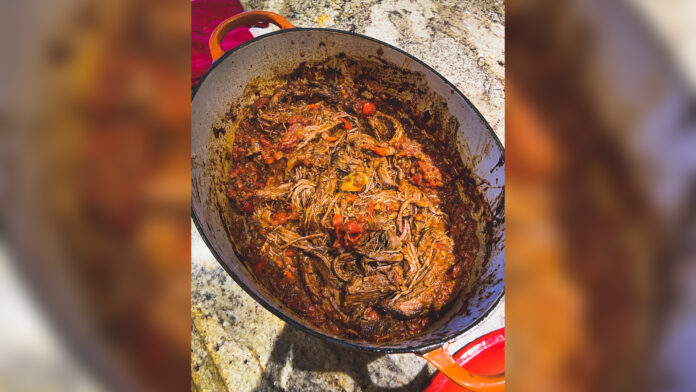Tips for making ropa vieja, maduros, Cuban-style black beans
Ropa vieja, Spanish for ‘old clothes,’ is named for its famed shreddy texture and possesses a balanced taste between the fatty nature of the braised, shredded beef and the acidity of the tomatoes and onions it’s simmered in. Randall Dobkin, a second-year political science and economics major, found this recipe on the Bon Appetit website and recommended it as a potential meal for quarantine cooking.
When making this dish, I also made the sides that the recipe recommended: maduros and Cuban-style black beans. Maduros, fried sweet plantains, proved to be the most complicated part of the meal, as ensuring they were at the correct ripeness and then frying them proved challenging for a novice cook such as myself. In addition, the plantains were sometimes too starchy in order to obtain the almost custardy texture inside, and the thickness of the plantains was hard to gauge, making it increasingly difficult to come out with a consistent result.
On the other hand, the Cuban-style black beans were a more basic addition to the meal. The slightly salty and tender black beans made the dish feel more authentic. This recipe would work well in omelets, tacos or even as a simple addition to salsa. By putting them on the stove to boil for three hours with onion and bell peppers, the beans become an intrinsic, hearty part of the meal. The beans balanced the meal of ropa vieja and can be substituted with other sides if time is a factor when making this dish.
The ropa vieja itself was relatively easy to make — I threw a variety of vegetables along with flank steak into the oven for three hours. The same recipe could be made even easier by using a slow cooker. Using a chuck roast, however, could be a better, and cheaper, substitution to the recipe. When cooking the flank steak, it was more difficult to create the soft and juicy texture that a chuck roast would have been able to perfect.
I finely chopped the onions and bell peppers that were put in, but I think the textural integrity of the dish was compromised by doing that. If I were to remake the dish, I would have thicker cuts of the vegetables, as the thin cut that I used made the onions and bell peppers less prominent in the final product.
The acidity of the tomatoes paired perfectly with the softness of the meat, and the final product was ideal for a lazy Saturday afternoon. In addition, any leftover meat can be eaten with a soft roll the following day for an American fusion lunch — a Cuban-style sloppy Joe of sorts.
I thought the recipe was incredibly easy, but the addition of the sides was stressful at times. Focusing on the ropa vieja itself or choosing to make just one of the sides with rice would have made it more enjoyable, instead of trying to make everything at once.
Written by: Athena Aghighi — features@theaggie.org




